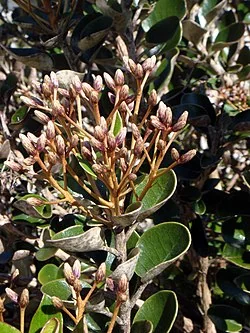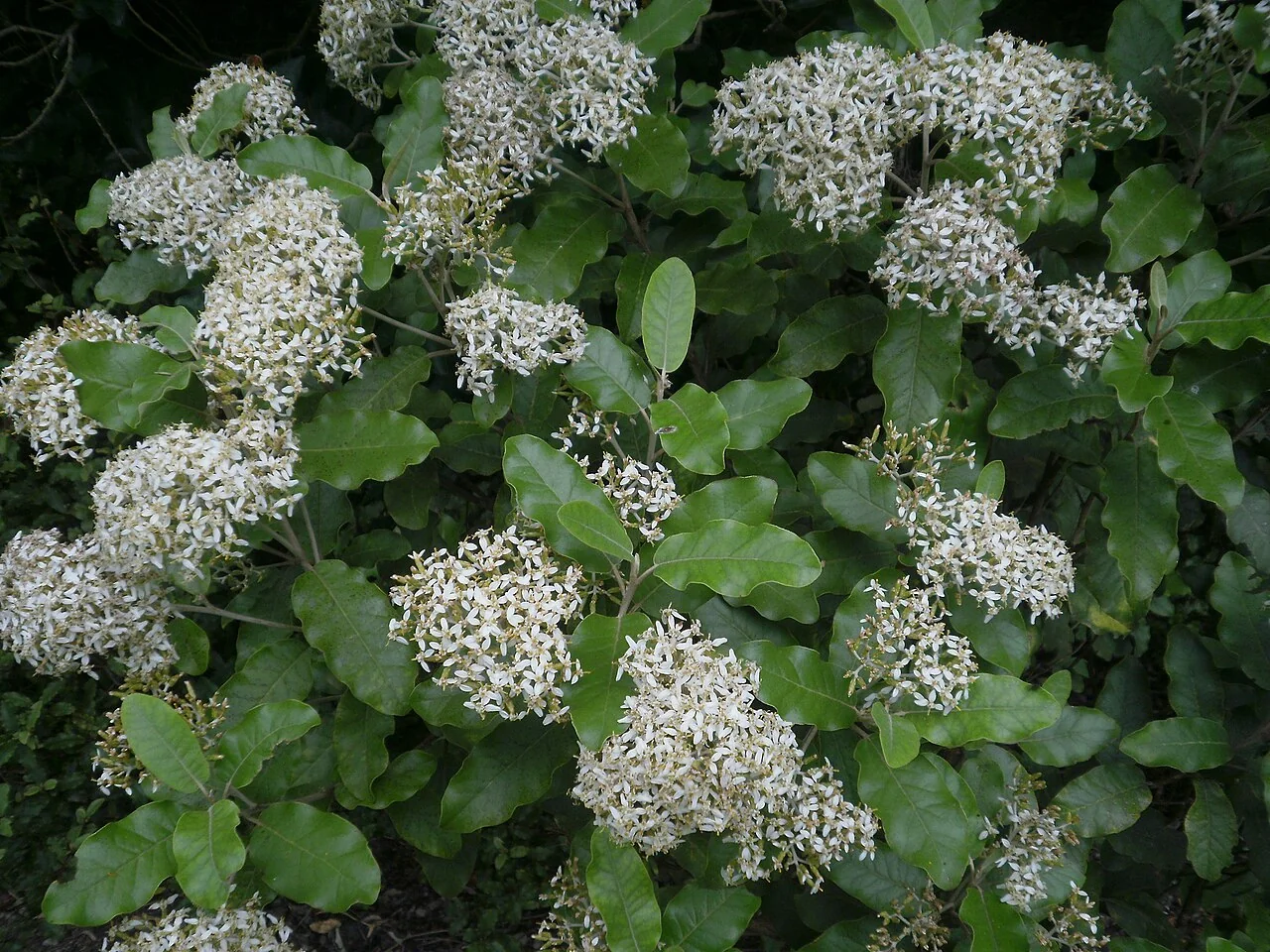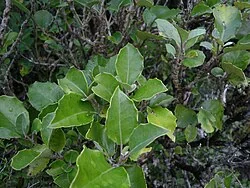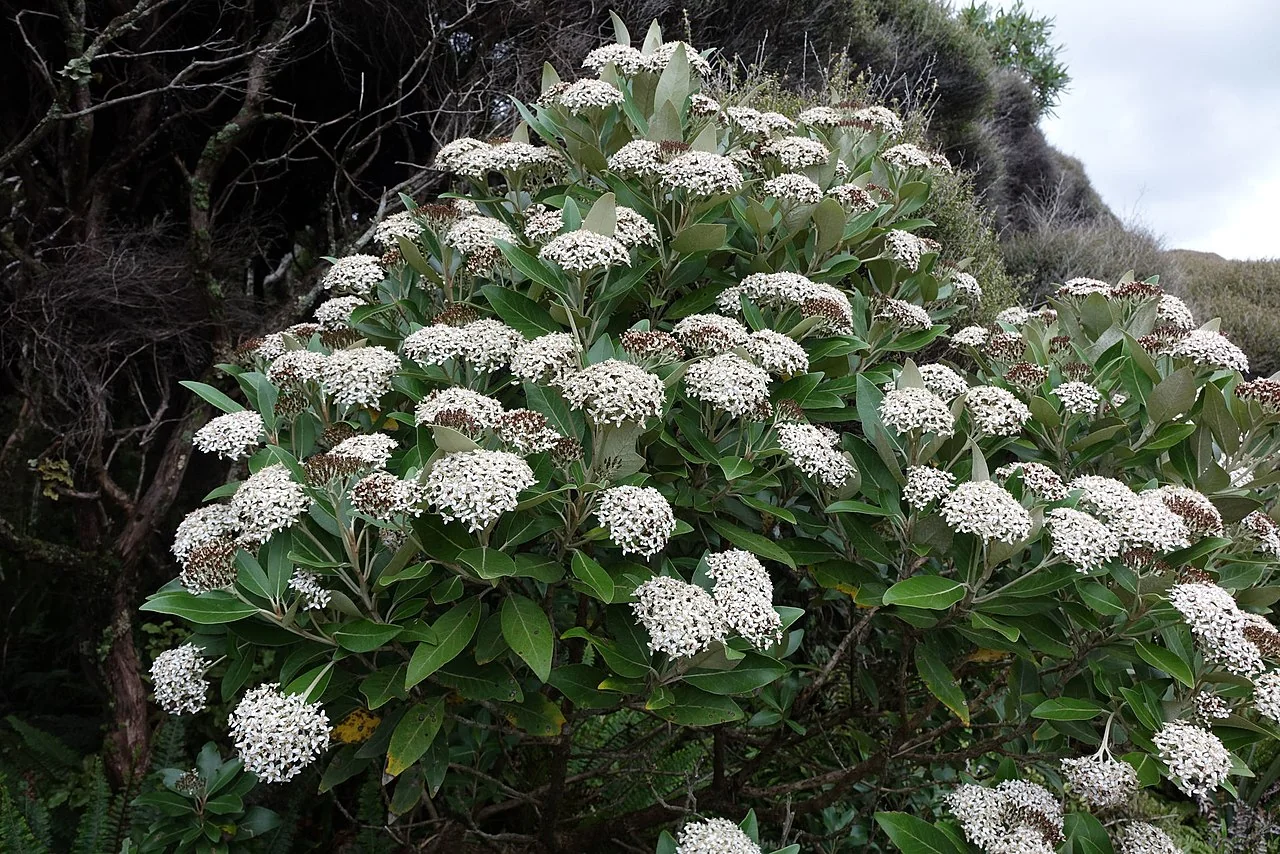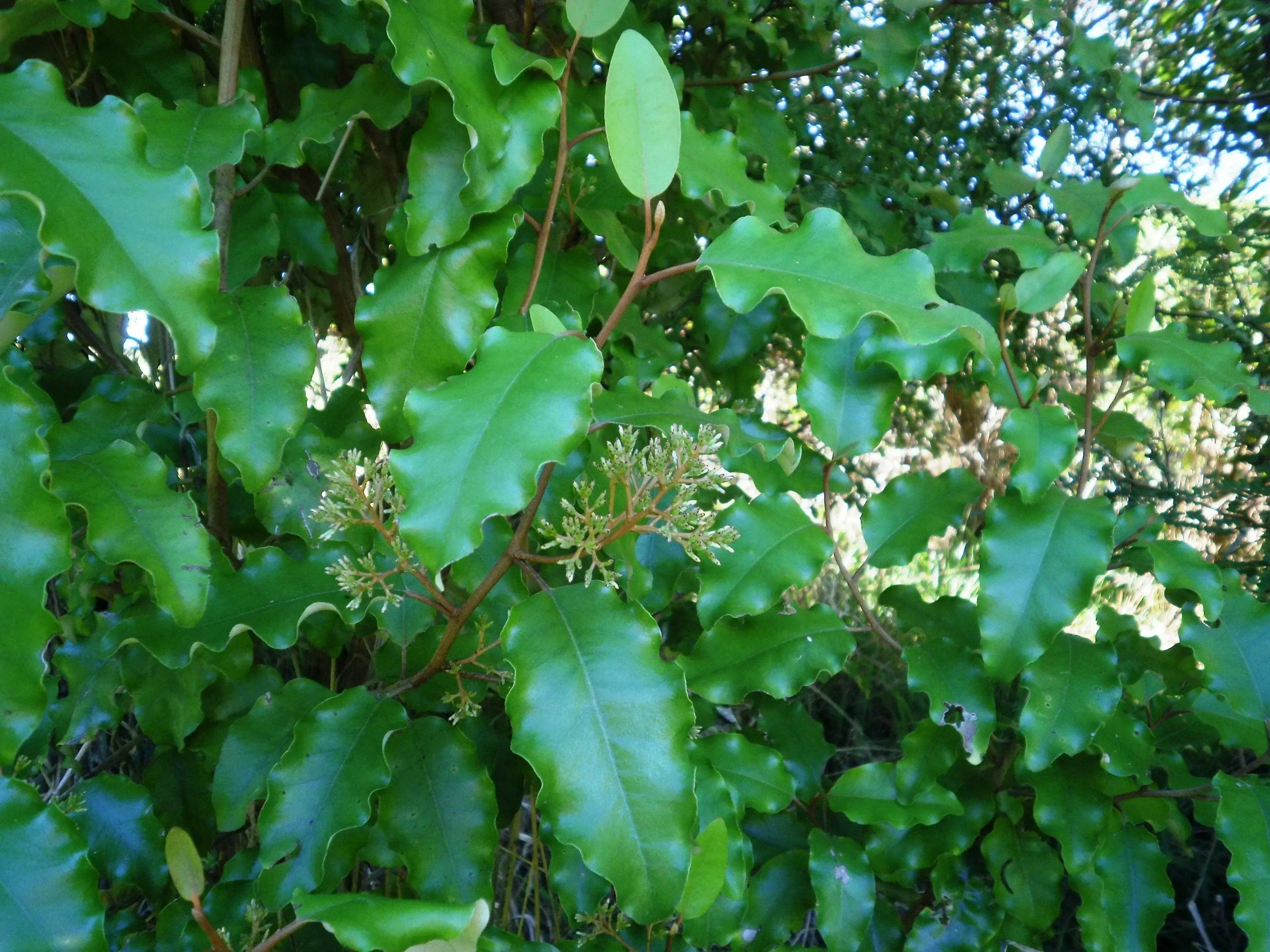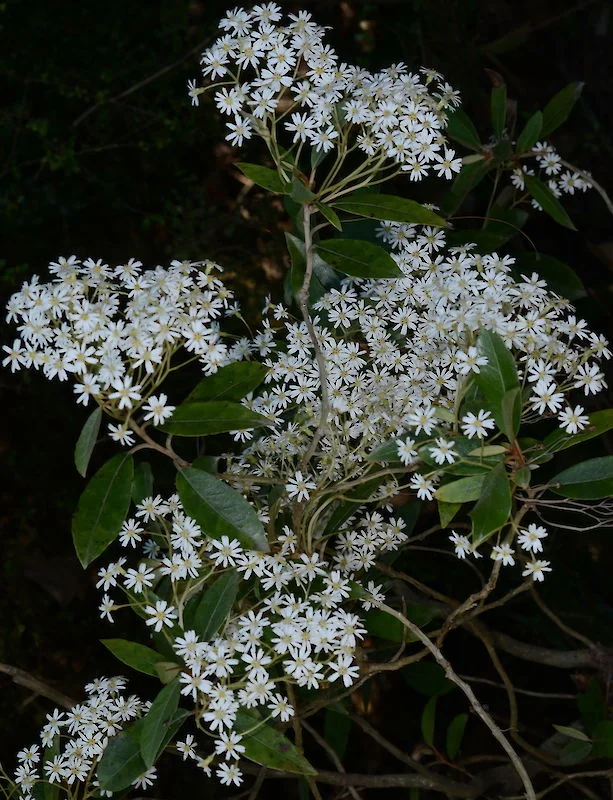
Cheeseman's Daisy
Olearia cheesemanii
Streamside Tree Daisy (scientific name: Olearia cheesemanii ) Streamside Tree Daisy is a native tree daisy that produces masses of small white or cream flowers. Like other Olearia species, it's valued for its hardy nature and ability to provide shelter and nectar for native wildlife. Explore more in the native plants index .

Plant Description
Botanical Features
Māori Context and Modern Kaitiakitanga
Although records of specific rongoā for Cheeseman's daisy are limited, larger Olearia (akeake) were noted by Māori for tough, durable timber suited to small implements. Today, Olearia cheesemanii is recognised as a taonga of alpine-montane river systems; iwi, community groups and botanists prioritise it in restoration plantings where stock exclusion, weed control and eco-sourced propagules help re-establish local whakapapa of tree daisies in limestone and schist gorges.
Cheeseman's Daisy ( Olearia cheesemanii ), also known as Streamside Tree Daisy, is a charming native evergreen shrub endemic to New Zealand. It typically grows to a height of 0.1 to 4 meters, and has a compact, rounded, or broadly columnar habit. Its bark is grey and tends to flake in long strips, and its young branchlets are grooved and covered in a buff or greyish-white downy tomentum. The foliage is a key feature: the leaves are small, narrow, lance-shaped, and thinly leathery, ranging from 4 to 10 cm long. They are dark green to grey-green and slightly toothed or sinuate on the upper side, with a soft buff, silvery, or pale brown downy covering on the underside. In spring and summer, it produces abundant clusters of small, delicate daisy-like flowers. These flowers have white ray florets and golden or yellow centers, creating a striking display.
Quick Facts
Overview
| Scientific Name | Olearia Cheesemanii |
|---|---|
| Height | 2-6 m |
| Spread | 2-4 m |
| Water Needs | Low to moderate |
| Light | Full sun to partial shade |
| Frost Tolerance | Moderate to good |
| Salt Tolerance | Moderate |
| Growth Rate | Moderate |
| Lifespan | Long-lived |
Climate Best Suited to
Regional climate suitability across major New Zealand cities.
Regional Suitability
| Whangārei | Ideal |
| Auckland | Ideal |
| Hamilton | Suitable |
| Rotorua | Suitable |
| Tauranga | Ideal |
| Gisborne | Ideal |
| New Plymouth | Ideal |
| Whanganui | Ideal |
| Palmerston North | Suitable |
| Napier | Ideal |
| Wellington | Ideal |
| Nelson | Ideal |
| Christchurch | Suitable |
| Dunedin | Suitable |
| Invercargill | Suitable |
| City | Climate Suitability |
|---|
Natural Habitat
Cheeseman's Daisy is an evergreen shrub native to New Zealand, primarily found in rocky river gorges. It thrives in consistently moist environments with moderate temperatures and good humidity. It can also be found in meadows and forests, preferring well-drained, consistently moist soils. It tolerates full sun to partial shade and is often found in forest edge settings.
Plant Conservation
Conservation
Olearia cheesemanii , also known as Cheeseman's Daisy or Streamside Tree Daisy, is a rare and threatened native shrub endemic to New Zealand. It is highly valued for its conservation importance and natural beauty, displaying stunning white daisy flowers in spring. This species is typically found in rocky river gorges, often in or near the flood zone, and along lowland streamsides at forest margins in both the North and South Islands of New Zealand. The current conservation status of Olearia cheesemanii is "At Risk - Declining" as of 2023, with previous classifications including "At Risk: Naturally Uncommon" in 2017 and 2012. The primary threats to Olearia cheesemanii include: invasive weeds such as mistflower and buddleia, habitat modification and loss, and river conversion for hydroelectric schemes. Surveys have indicated a population structure skewed towards older adult plants, with few juveniles and seedlings surviving due to weed competition. Conservation efforts and management opportunities include propagation and re-establishment, habitat protection, survey and monitoring, and raising awareness. Growing Olearia cheesemanii in gardens contributes to conservation efforts by ensuring the species survives beyond its threatened natural habitat.
Growing Requirements
Soil Requirements
Adapted to alpine/subalpine, rocky, free-draining sites; avoid heavy wet soils.
Light Requirements
Full sun for compact habit; tolerates frost and exposure.
Water Requirements
Low-moderate; water to establish, then sparingly.
Planting Guide
Site Selection and Light:
Choose a location that receives full sun to partial shade. While it tolerates various light conditions, it flowers best in good light and appreciates morning sun with afternoon protection. It can also grow in dappled light in forest edge settings. Protection from strong winds is beneficial.
Soil Requirements:
Olearia cheesemanii prefers well-draining but consistently moist soils. It can adapt to various soil types with adequate drainage and benefits from organic-rich soils. Avoid waterlogged conditions. It tolerates rocky or gravelly substrates and prefers a neutral to slightly acidic pH (6.1 to 7.5).
Watering:
This plant has moderate to high water needs, reflecting its natural river gorge habitat. Consistently moist soil is preferred year-round, with more water needed during establishment and flowering. Watering every week is recommended to maintain its water balance. Mulching around the base helps retain soil moisture. Drought stress can significantly impact plant health.
Ecological Role
Olearia cheesemanii enhances dry montane shrublands with reliable floral resources and wind-borne seed.
Pollinator Support
- Nectar and pollen: Flower heads draw a range of insects, sustaining pollinator communities.
- Wind-dispersed achenes: Seed travels to fresh gravels and open faces, aiding colonisation.
Stability and Shelter
- Slope binding: Root systems stabilise thin, rocky soils on exposed slopes.
- Edge shelter: Compact foliage reduces wind stress for companion plants.
By coupling pollinator food with erosion control, O. cheesemanii supports resilient shrublands.
Uses and Significance
Garden Applications
Olearia cheesemanii is an excellent flowering shrub that thrives in standard garden conditions, tolerating both shade and full sun. Its robust nature makes it ideal for high-country gardens, windy sites, and coastal plantings where salt tolerance is valuable. The numerous clusters of white daisy flowers create a showy display that enhances both bush and garden settings.
The abundant white daisy blossoms are highly attractive to pollinators and contribute significantly to local biodiversity. This fast-growing shrub provides excellent habitat and food sources for native insects and birds, making it valuable for revegetation projects and native plant restoration efforts.
Cultural Significance
Cultural Importance
Botanical Heritage
Olearia cheesemanii commemorates Thomas Frederick Cheeseman, author of The Manual of the New Zealand Flora (1906). Its naming links the plant to the formative period of New Zealand botany, when many mountain-daisy species were first documented from remote river gorges and alpine slopes. Cultivating the species in public and private collections helps keep that botanical history visible and relevant today.
Ecological Value
shrub's As a naturally rare shrub of rocky stream margins and bluffs, planting it in restoration settings and alpine-style gardens can support local biodiversity and preserve distinctive riparian shrubland character.
Conservation and Identity
"At Risk - Declining" Featuring it in regionally appropriate plantings and weed-managed riparian projects raises awareness of threatened native shrubs and their unique river-gorge habitats. New Zealand's
Landscaping Ideas
Cheeseman's Daisy ( Olearia cheesemanii ) is an exceptionally versatile and hardy native shrub that excels in a wide variety of landscaping applications. Its remarkable adaptability to different growing conditions, combined with spectacular seasonal displays of white daisy flowers and excellent wildlife value, makes it an outstanding choice for both formal and naturalistic garden designs.
Coastal and Exposed Sites
- Windbreak plantings: Outstanding resistance to salt-laden winds makes it perfect for coastal gardens and exposed sites where many plants struggle. Plant in rows 40-50 cm apart to create effective windbreaks that protect more tender species.
- Coastal stabilization: Root systems help stabilize soil and prevent erosion, especially valuable on coastal banks, dunes, and clifftops where natural stabilization is needed.
- Salt-tolerant borders: Thrives in seaside gardens where salt spray would damage other plants, providing reliable structure and seasonal colour in challenging maritime conditions.
Formal Garden Applications
- Hedge formation: Dense, compact growth habit makes it excellent for formal or informal hedging. Regular light trimming maintains neat, defined shapes while preserving flowering potential.
- Specimen planting: Individual plants create striking focal points with their abundant white flower displays and attractive silver-green foliage, particularly effective against darker backgrounds.
- Border and foundation plantings: Provides excellent structure and year-round interest in mixed borders, with spring flowering complementing early bulbs and perennials.
Naturalistic and Native Gardens
- Wildlife gardens: Flowers provide crucial nectar for native bees, butterflies, and other pollinators, while dense branching offers shelter and nesting sites for small birds and beneficial insects.
- Restoration plantings: Fast growth and hardy nature make it valuable for revegetation projects, particularly in rocky, exposed areas where establishment can be challenging.
- Rock gardens: Naturally adapted to rocky, free-draining sites, making it perfect for alpine-style gardens and rock gardens where good drainage is essential.
Practical Landscaping Benefits
- Low maintenance: Once established, requires minimal care beyond occasional light pruning, making it ideal for low-maintenance landscapes and public spaces.
- Drought tolerance: Well-suited for xeriscaping and water-wise gardens, particularly valuable in areas with limited irrigation or during dry periods.
- Erosion control: Root systems help stabilize slopes and banks, making it valuable for practical landscaping on challenging terrain.
- Seasonal interest: Provides extended flowering displays from late spring through summer, followed by interesting seed heads that attract seed-eating birds.
Seasonal Care Calendar
Spring
Plant new specimens or divide established clumps of Cheeseman's Daisy. Perform light tip-pruning to encourage a bushy habit and more abundant flowering, ensuring fresh growth.
Summer
Water sparingly; established plants are drought-tolerant. Avoid over-fertilizing, which can lead to weak, leggy growth.
Autumn
Shape the plant after flowering to maintain its compact form and remove any spent blooms, preparing it for the cooler months.
Winter
Cheeseman's Daisy is hardy and tolerates moderate frosts. Ensure excellent drainage around the crown to prevent root rot in wet conditions.
Pruning and Maintenance
Techniques and Timing
Olearia cheesemanii benefits from regular light pruning to maintain its dense, compact habit. Tip pruning immediately after blooming encourages a denser growth pattern and more abundant flowering in the following season. Light clipping throughout the growing season helps keep plants tidy and well-shaped. While this species can tolerate hard pruning if necessary, avoid severe cuts into old wood as this may compromise the plant's natural form and flowering capacity.
How to Grow Cheeseman's Daisy
Cheeseman's Daisy is a robust native shrub or small tree that creates spectacular displays of masses of small white or cream daisy flowers, typically blooming prolifically in late summer and autumn. This hardy member of the Asteraceae family is naturally found in forest margins, scrublands, and coastal areas throughout New Zealand, where it has adapted to challenging conditions including wind, drought, and poor soils. Cheeseman's Daisy is particularly valued in cultivation for its fast growth, reliable flowering, and exceptional wildlife value, providing crucial late-season nectar when many other plants have finished blooming, while its dense branching structure offers shelter for small birds and beneficial insects throughout the year. Understanding its propagation methods is key to successfully growing this delightful species.
From Cuttings
Semi-hardwood cuttings are a reliable and efficient method for propagating Cheeseman's Daisy, ensuring that new plants retain the exact characteristics of the parent. Take 8-10 cm cuttings from healthy, non-flowering shoots in late summer from current season's growth. Dip in rooting hormone and place in a well-draining propagation mix. Maintain consistent humidity with misting or enclosed propagation chambers. Successful rooting typically occurs within 6-8 weeks under warm, humid conditions. Once rooted, the new plants can be potted on and grown in a sheltered environment until they are ready for planting.
From Seed
Propagating Cheeseman's Daisy from seed is a viable method, though it requires fresh seeds and careful attention to conditions. Collect fine seed from dried flower heads in late autumn, storing in cool, dry conditions until sowing in spring. Surface-sow without covering on a free-draining seed mix, as seed requires exposure to light for optimal germination. Maintain consistent moisture without waterlogging, with germination typically occurring within 2-4 weeks under suitable conditions of 18-20°C. Seedlings develop quickly and transplant readily when large enough to handle safely. This method is crucial for maintaining genetic diversity and for large-scale restoration projects.
Pests and Diseases
Cheeseman's Daisy ( Olearia cheesemanii ) is generally a trouble-free and resilient native shrub that experiences few serious pest or disease problems when grown in appropriate conditions. Its natural hardiness and adaptation to challenging environments, including coastal exposure and alpine conditions, contributes to its overall robust health and disease resistance.
Disease Resistance
- Honey fungus tolerance: Shows good resistance to honey fungus ( Armillaria species), a common soil-borne pathogen that affects many woody plants, making it reliable for long-term garden plantings.
- Fungal diseases: Generally resistant to most common fungal infections due to its adaptation to well-draining soils and good air circulation requirements.
- Root rot prevention: Excellent drainage requirements naturally prevent most water-related root diseases, provided planting sites avoid waterlogged conditions.
Environmental Stress Prevention
- Drought stress: While drought-tolerant once established, prolonged dry periods without adequate moisture can cause leaf browning and reduced flowering. Maintain consistent moisture during extended dry spells.
- Waterlogging damage: Poor drainage can lead to root rot and decline. Ensure excellent drainage, particularly in clay soils or areas prone to water accumulation.
- Wind protection: Although highly wind-resistant, extremely severe winds in exposed locations may cause some foliage damage. Provide initial protection for young plants until well-established.
Pest Management
- Scale insects: Occasionally affected by soft scale or hard scale insects, particularly in sheltered garden situations. Monitor regularly and treat with horticultural oil if infestations develop.
- Aphids: May occasionally attract aphids during spring growth periods. These are usually controlled naturally by beneficial insects, but serious infestations can be managed with insecticidal soap.
- Browsing damage: Young plants may be susceptible to damage from rabbits or possums. Protect new plantings with appropriate barriers until plants are well-established.
Competition Management
- Weed competition: In natural habitats, aggressive weeds like mistflower and buddleia can smother young plants. In cultivation, maintain weed-free areas around new plantings to ensure successful establishment.
- Grass competition: Vigorous grasses can compete with young plants for nutrients and moisture. Keep grass cleared from around the base of plants, particularly during the establishment phase.
Regular monitoring and maintaining appropriate growing conditions - particularly ensuring good drainage, adequate spacing for air circulation, and avoiding overwatering - will prevent most potential problems and keep plants healthy and vigorous.
Bonus Tip
Expert Growing Advice
Cheeseman's daisy ( Olearia cheesemanii ) favors cool roots and moist air. In river- stone gardens, tuck plants on the shaded side of boulders and mulch with fine gravel to prevent splash on leaves; this keeps tomentose undersides clean and showy.

